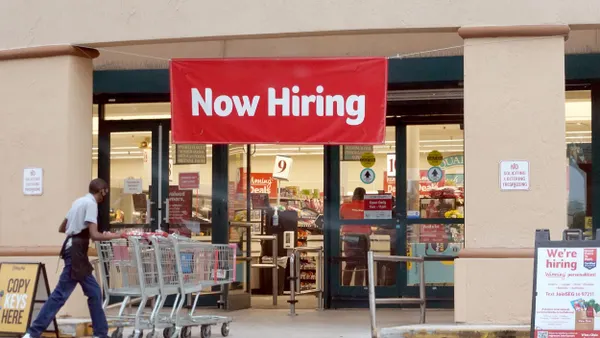While it's only natural to feel some FOMO in this unique hiring environment, companies that move too quickly will regret it later. Heading into this new era of work, it's important to work quickly, but also carefully and strategically—by identifying who the candidates flooding the job market are, what they care about, and how you can best get them to apply, accept an offer, and stick around a while.
Here are some proven ways to increase your odds of making quality, long-term hires in this strange new moment in the job market.
#1 – Take a fresh look at your job descriptions to increase your odds of making quality, long-term hires
Just because a job description has worked in the past doesn't mean you should use it as is—and this is especially true now.
With so many positions available, candidates' preferences changing, and job seekers embarking on new career paths, it’s possible the ideal skill set for the role you're hiring for has changed, too.
To make sure your postings capture the real, on-the-ground competencies needed to succeed in a role, consider conducting a fresh job analysis of your some of your most critical open roles, with counsel from the hiring manager and their team—and, if possible, an I-O consultant.
Make sure ideal competencies are emphasized as much, if not more, than required years' experience and education. As we all know, just because a candidate has experience in a field doesn't mean they've necessarily been successful in that field.
#2 – Create a mobile-first application experience
Did you know that more than 90 percent of job seekers look for their next role on their phones? Since our phones go everywhere with us, a mobile-first experience for job applications is a must. If applying by smartphone is frustrating, candidates will bail and never look back—especially in this candidate-friendly environment.
Some tips:
-
Evaluate the ATS you're using. Are you making candidates re-enter information that's already on their resumes? (Don't do this.) How much time does it take to complete the process?
-
Make it easier for phone users to digest information quickly. Use conversational language and short paragraphs. And make things scannable with sub-headers and bulleted lists.
-
Lastly, consider including short testimonials from employees talking about their positive experience at your company somewhere on your careers page to help motivate visitors to follow through on applying.
#3 – Reimagine your sourcing pool
According to the Associated Press, the extended break from normal we all experienced last year has led many workers to reevaluate their career choices.
Many who were laid off or who felt too scared to leave their position with the world on fire realized they didn't actually love what they were doing—and decided to pursue something new. Others who were freelancing or who took a hiatus to care for their kids are now back on the market, looking for full-time work.
Finding and hiring these less traditional candidates will require more than posting a few ads on Indeed, Monster, and LinkedIn and calling it a day.
A few other venues to look into are:
Google Job Search
If you're wondering where to post jobs, consider that 73 percent of candidates begin their job hunt with Google. Google Job Search is an ideal platform for reaching candidates before they even progress to the job board.
Adding your voice to conversational community networking sites like Reddit will help you find active and passive job seekers.
WayUp
To reach early career candidates, try WayUp, a job board for college students and recent grads.
Also, consider expanding your recruiting into colleges and trade schools you might not have dealt with before and setting up social media "get the word out" campaigns targeted to specific subgroups of candidates.
#4 – Supercharge your referral program
With the exponential rise of remote workplaces, the number of viable job candidates your employees know personally has grown exponentially, too—especially now that so many people are either leaving or thinking about leaving their jobs.
Leveraging your employees' internal connections through a referral program can help you get in front of these kinds of candidates early on in their job hunt.
To encourage engagement with the program, consider bumping up your referral bonus, too.
#5 – Consider freelancers and contract workers
If you're struggling to fill open full-time roles, you're likely feeling pressure (either self-imposed of from leadership) to hire quickly. One way to solve the problem is to change the parameters of the job to include freelance or contract workers who now make up 12 percent of the U.S. workforce.
While it's common to hire contract workers for short-term projects, it can also be beneficial to your organization to partner for the long-term, too. And if you do decide to bring on these workers full-time, you won't need to spend as much time training them, since they'll already be acquainted with the work and your company culture.
#6 – Use valid, reliable, pre-employment assessments
No matter how many applications you're receiving, adding a valid, reliable pre-employment assessment to your process can help screen out poor fits quickly, freeing you up to focus on your best candidates.
Resumes, referrals, and interviews are all integral parts of the hiring process, but multi-measure tests provide a unique layer of objective data that directly applies to the candidate's on-the-job performance.
And if you're concerned that adding an assessment to your process will turn away applicants who want to apply as quickly as possible, consider two things:
-
First, any applicant who is serious about the role will happily take an assessment; those who refuse probably weren't that interested in the first place.
-
Second, assessments are viewed favorably by candidates; in other words, they can enhance their candidate experience. Recent studies show that applicants like having the chance to demonstrate what they’re capable of, and longer tests that take between 10 and 30 minutes to complete are viewed as fairer and more useful than tests taking less than 10 minutes.










